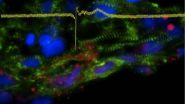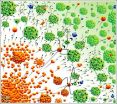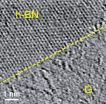(Press-News.org) Chances are the only thing you remember about your first swig of alcohol is how bad the stuff tasted. What you didn't know is the person who gave you that first drink and when you had it says a lot about your predisposition to imbibe later in life.
A national study by a University of Iowa-led team has found that adolescents who get their first drink from a friend are more likely to drink sooner in life, which past studies show makes them more prone to abusing alcohol when they get older. The finding is designed to help specialists predict when adolescents are likely to first consume alcohol, with the aim of heading off problem drinking at the pass.
"When you start drinking, even with kids who come from alcoholic families, they don't get their first drinks from their family," says Samuel Kuperman, a child and adolescent psychiatrist at the UI. "They get their first drinks from their friends. They have to be able to get it. If they have friends who have alcohol, then it's easier for them to have that first drink."
The basis for the study, published this month in the journal Pediatrics, is compelling: One-third of eighth graders in the United States report they've tried alcohol, according to a 2011 study of 20,000 teenagers conducted by the University of Michigan and funded by the National Institutes of Health. By 10th grade, more than half say they've had a first drink, and that percentage shoots to 70 percent by their senior year.
"There's something driving kids to drink," explains Kuperman, corresponding author on the paper. "Maybe it's the coolness factor or some mystique about it. So, we're trying to educate kids about the risks associated with drinking and give them alternatives."
Kuperman and his team built their formula from two longstanding measures of adolescent drinking behavior—the Semi-Structured Assessment for the Genetics and Alcoholism and the Achenbach Youth Self Report. From those measures of nearly two-dozen variables and a review of the literature, the UI-led team found five to be the most important predictors: two separate measures of disruptive behavior, a family history of alcohol dependence, a measure of poor social skills, and whether most best friends drink alcohol.
The researchers then looked at how the five variables worked in concert.
Surprisingly, a best friend who drank and had access to alcohol was the most important predictor. In fact, adolescents whose best friend used alcohol were twice as likely to have a first drink, the researchers found. Moreover, if considered independently of the other variables, teenagers whose best friends drank are three times as likely to begin drinking themselves, the study found, underscoring the sway that friends have in adolescents' drinking behavior.
"Family history doesn't necessarily drive the age of first drink," notes Kuperman, who has studied teen drinking for more than a decade. "It's access. At that age (14 or 15), access trumps all. As they get older, then family history plays a larger role."
The current study drew from a pool of 820 adolescents at six sites across the country. The participants were 14 to 17 years old, with a median age of 15.5, nearly identical to the typical age of an adolescent's first drink found in previous studies. More than eight in 10 respondents came from what the researchers deemed high-risk families, but more than half of the teenagers had no alcohol-dependent parents.
Tellingly, among those adolescents who reported having had drunk alcohol, nearly four in ten said their best friends also drank.
The result underscores previous findings that teenagers who have their first drink before 15 years of age are more likely to abuse alcohol or become dependent. It also supports the screening questions selected in the National Institute on Alcohol Abuse and Alcoholism and the American Academy of Pediatrics initiative to identify and help youth at risk for alcohol use, the researchers write.
Kuperman, whose faculty appointment is in the Carver College of Medicine, says he hopes to use the study to delve into the genetics underpinning alcoholism, chiefly tracking adolescents who use alcohol and see whether they have genes that match up with their parents if they also are problem drinkers.
"We're trying to separate out those who experiment with alcohol to those who go on to problematic drinking," he says.
### Contributing authors include John Kramer from the UI; Grace Chan and Victor Hesselbrock, University of Connecticut Health Center; Leah Wetherill, Indiana University School of Medicine; Kathleen Bucholz, Washington University School of Medicine in St. Louis; Danielle Dick, Virginia Commonwealth University; Bernice Porjesz and Madhavi Rangaswamy, State University of New York Downstate Medical Center, Brooklyn; and Marc Schuckit (principal investigator on the grant), University of California San Diego School of Medicine.
The National Institutes of Health (grant number: 5 U10 AA008401), the National Institute on Alcohol Abuse and Alcoholism and the National Institute on Drug Abuse funded the study.
Best friends influence when teenagers have first drink
U. Iowa study notes friends' access to alcohol as main reason
2013-01-28
ELSE PRESS RELEASES FROM THIS DATE:
Patients' own skin cells are transformed into heart cells to create 'disease in a dish'
2013-01-28
LA JOLLA, Calif., January 27, 2013 – Most patients with an inherited heart condition known as arrhythmogenic right ventricular dysplasia/cardiomyopathy (ARVD/C) don't know they have a problem until they're in their early 20s. The lack of symptoms at younger ages makes it very difficult for researchers to study how ARVD/C evolves or to develop treatments. A new stem cell-based technology created by 2012 Nobel Prize winner Shinya Yamanaka, M.D., Ph.D., helps solve this problem. With this technology, researchers can generate heart muscle cells from a patient's own skin cells. ...
Demagnetization by rapid spin transport
2013-01-28
For purposes of their research, the scientists irradiated two separate layered systems with ultrashort laser pulses on the order of just one hundred femtoseconds (10-15 s). One sample consisted essentially of a single thin layer of ferromagnetic nickel. By contrast, a second sample of this same nickel material was coated with a non-magnetic layer of gold. Only a mere 30 nanometers (10-9 m) thick, the gold layer swallowed up the lion's share of the laser light so that barely any light ended up reaching the nickel layer. In spite of this, the nickel layer's magnetization ...
Accelerating neutral atoms on a table top
2013-01-28
Charged particle accelerators have become crucially important to modern day life, be it in health care for cancer treatment or for answering important fundamental scientific questions like the existence of the HIGGS boson, the so called 'God particle'. In a simple picture, charged particles like electrons and protons are accelerated between two end plates across which an electrical voltage is applied. High energies need high voltages (millions and billions of volts) and long acceleration paths in giant sized machines – for instance the trillion volt machine called the 'large ...
Rice technique points toward 2-D devices
2013-01-28
HOUSTON – (Jan. 28, 2013) – Rice University scientists have taken an important step toward the creation of two-dimensional electronics with a process to make patterns in atom-thick layers that combine a conductor and an insulator.
The materials at play – graphene and hexagonal boron nitride – have been merged into sheets and built into a variety of patterns at nanoscale dimensions.
Rice introduced a technique to stitch the identically structured materials together nearly three years ago. Since then, the idea has received a lot of attention from researchers interested ...
Cities affect temperatures for thousands of miles
2013-01-28
BOULDER – Even if you live more than 1,000 miles from the nearest large city, it could be affecting your weather.
In a new study that shows the extent to which human activities are influencing the atmosphere, scientists have concluded that the heat generated by everyday activities in metropolitan areas alters the character of the jet stream and other major atmospheric systems. This affects temperatures across thousands of miles, significantly warming some areas and cooling others, according to the study in Nature Climate Change.
The extra "waste heat" generated from ...
Stem cells aid recovery from stroke
2013-01-28
Stem cells from bone marrow or fat improve recovery after stroke in rats, finds a study published in BioMed Central's open access journal Stem Cell Research & Therapy. Treatment with stem cells improved the amount of brain and nerve repair and the ability of the animals to complete behavioural tasks.
Stem cell therapy holds promise for patients but there are many questions which need to be answered, regarding treatment protocols and which cell types to use. This research attempts to address some of these questions.
Rats were treated intravenously with stem cells or ...
Measuring the consequence of forest fires on public health
2013-01-28
Pollution from forest fires is impacting the health of people with asthma and other chronic obstructive lung diseases, finds a study in Biomed Central's open access journal Environmental Health. This study uses data from pharmacies and dispensaries to measure the increase in drugs needed to alleviate symptoms associated with pollution.
Forest fires burn nearly 1000 km2 of trees in British Columbia every year. The Ministry of Environment keeps a close watch on levels of particulate matter in the air caused by these fires but it is harder to measure the impact of this ...
Poor sleep in old age prevents the brain from storing memories
2013-01-28
The connection between poor sleep, memory loss and brain deterioration as we grow older has been elusive. But for the first time, scientists at the University of California, Berkeley, have found a link between these hallmark maladies of old age. Their discovery opens the door to boosting the quality of sleep in elderly people to improve memory.
UC Berkeley neuroscientists have found that the slow brain waves generated during the deep, restorative sleep we typically experience in youth play a key role in transporting memories from the hippocampus – which provides short-term ...
In breast cancer metastasis, researchers identify possible drug target
2013-01-28
The spread of breast cancer to distant organs within the body, an event that often leads to death, appears in many cases to involve the loss of a key protein, according to UC San Francisco researchers, whose new discoveries point to possible targets for therapy.
In the January 27, 2013 online edition of Nature Cell Biology, UCSF scientists describe for the first time how the protein, known as GATA3 — which is abnormal or absent in many cases of human breast cancer — normally acts downstream in biochemical pathways to prevent the distant spread of cancer, an event called ...
Less invasive treatment may increase survival in early stage breast cancer
2013-01-28
DURHAM, N.C. -- Patients with early stage breast cancer who are treated with lumpectomy plus radiation have a better chance of survival compared with those who undergo mastectomy, according to Duke Medicine research.
The study, which appears online Jan. 28, 2013, in the journal CANCER, demonstrates the effectiveness of breast-conserving therapies such as lumpectomy, where only the tumor and surrounding tissue are surgically removed.
"Our findings support the notion that less invasive treatment can provide superior survival to mastectomy in stage I or stage II breast ...
LAST 30 PRESS RELEASES:
Injectable breast ‘implant’ offers alternative to traditional surgeries
Neuroscientists devise formulas to measure multilingualism
New prostate cancer trial seeks to reduce toxicity without sacrificing efficacy
Geometry shapes life
A CRISPR screen reveals many previously unrecognized genes required for brain development and a new neurodevelopmental disorder
Hot flush treatment has anti-breast cancer activity, study finds
Securing AI systems against growing cybersecurity threats
Longest observation of an active solar region
Why nail-biting, procrastination and other self-sabotaging behaviors are rooted in survival instincts
Regional variations in mechanical properties of porcine leptomeninges
Artificial empathy in therapy and healthcare: advancements in interpersonal interaction technologies
Why some brains switch gears more efficiently than others
UVA’s Jundong Li wins ICDM’S 2025 Tao Li Award for data mining, machine learning
UVA’s low-power, high-performance computer power player Mircea Stan earns National Academy of Inventors fellowship
Not playing by the rules: USU researcher explores filamentous algae dynamics in rivers
Do our body clocks influence our risk of dementia?
Anthropologists offer new evidence of bipedalism in long-debated fossil discovery
Safer receipt paper from wood
Dosage-sensitive genes suggest no whole-genome duplications in ancestral angiosperm
First ancient human herpesvirus genomes document their deep history with humans
Why Some Bacteria Survive Antibiotics and How to Stop Them - New study reveals that bacteria can survive antibiotic treatment through two fundamentally different “shutdown modes”
UCLA study links scar healing to dangerous placenta condition
CHANGE-seq-BE finds off-target changes in the genome from base editors
The Journal of Nuclear Medicine Ahead-of-Print Tip Sheet: January 2, 2026
Delayed or absent first dose of measles, mumps, and rubella vaccination
Trends in US preterm birth rates by household income and race and ethnicity
Study identifies potential biomarker linked to progression and brain inflammation in multiple sclerosis
Many mothers in Norway do not show up for postnatal check-ups
Researchers want to find out why quick clay is so unstable
Superradiant spins show teamwork at the quantum scale
[Press-News.org] Best friends influence when teenagers have first drinkU. Iowa study notes friends' access to alcohol as main reason




